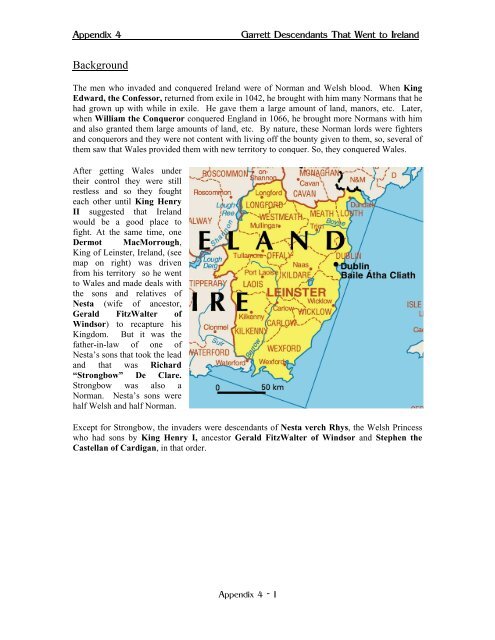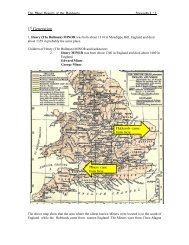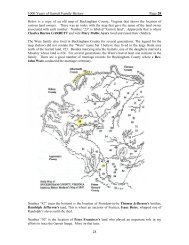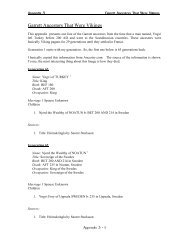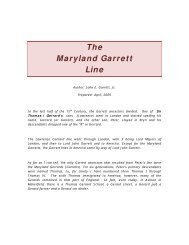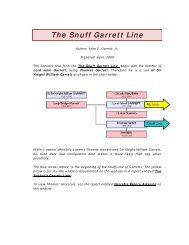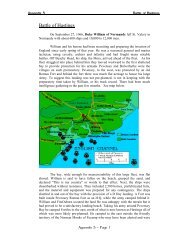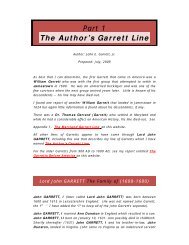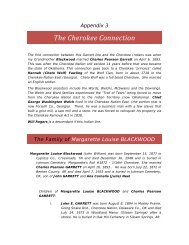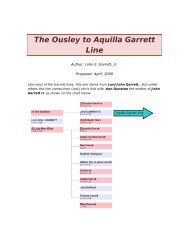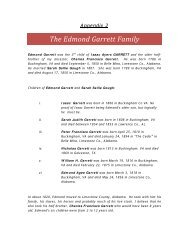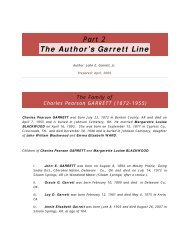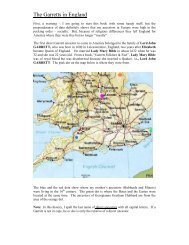Thomas fitzMaurice fitzThomas, - geraldini.com
Thomas fitzMaurice fitzThomas, - geraldini.com
Thomas fitzMaurice fitzThomas, - geraldini.com
Create successful ePaper yourself
Turn your PDF publications into a flip-book with our unique Google optimized e-Paper software.
Appendix 4 Garrett Descendants That Went to Ireland<br />
Background<br />
The men who invaded and conquered Ireland were of Norman and Welsh blood. When King<br />
Edward, the Confessor, returned from exile in 1042, he brought with him many Normans that he<br />
had grown up with while in exile. He gave them a large amount of land, manors, etc. Later,<br />
when William the Conqueror conquered England in 1066, he brought more Normans with him<br />
and also granted them large amounts of land, etc. By nature, these Norman lords were fighters<br />
and conquerors and they were not content with living off the bounty given to them, so, several of<br />
them saw that Wales provided them with new territory to conquer. So, they conquered Wales.<br />
After getting Wales under<br />
their control they were still<br />
restless and so they fought<br />
each other until King Henry<br />
II suggested that Ireland<br />
would be a good place to<br />
fight. At the same time, one<br />
Dermot MacMorrough,<br />
King of Leinster, Ireland, (see<br />
map on right) was driven<br />
from his territory so he went<br />
to Wales and made deals with<br />
the sons and relatives of<br />
Nesta (wife of ancestor,<br />
Gerald FitzWalter of<br />
Windsor) to recapture his<br />
Kingdom. But it was the<br />
father-in-law of one of<br />
Nesta’s sons that took the lead<br />
and that was Richard<br />
“Strongbow” De Clare.<br />
Strongbow was also a<br />
Norman. Nesta’s sons were<br />
half Welsh and half Norman.<br />
Except for Strongbow, the invaders were descendants of Nesta verch Rhys, the Welsh Princess<br />
who had sons by King Henry I, ancestor Gerald FitzWalter of Windsor and Stephen the<br />
Castellan of Cardigan, in that order.<br />
Appendix 4 - 1
Appendix 4 Garrett Descendants That Went to Ireland<br />
The sons and grandsons of Nesta that were substantially involved in the Irish Invasion via each of<br />
the three men are as follows:<br />
King Henry I and his Mistress, Nesta<br />
Henry FitzHenry<br />
Meyler FitzHenry<br />
Robert FitzHenry<br />
Gerald FitzWalter of Windsor and his wife, Nesta<br />
Maurice FitzGerald (leader of 3 rd landing) (son of Gerald and Nesta)<br />
William FitzMaurice (son-in-law of Richard Strongbow De Clare) (grandson)<br />
Gerald FitzMaurice (grandson)<br />
<strong>Thomas</strong> Fitzmaurice (grandson)<br />
Maurice FitzMaurice (grandson)<br />
David FitzGerald (Bishop of St. Davids) (son of Gerald and Nesta)<br />
William FitzGerald (Lord of Carew Castle) (son of Gerald and Nesta)<br />
Raymond le Gros FitzWilliam (leader of 4 th landing) (grandson)<br />
Griffin FitzWilliam (grandson)<br />
Angareta FitzGerald (daughter of Gerald and Nesta)<br />
Stephen, Castellan of Cardigan and his wife, Nesta<br />
Robert FitzStephen (leader of 1 st landing)<br />
Meridith FitzRobert<br />
Ralf FitzRobert<br />
Geoffrey FitzRobert<br />
The invasion campaigns were staged over a four-year period.<br />
• Pre-Invasion - 1167 - Dermot MacMurrough and Flemings under Richard<br />
FitzGodebert<br />
• Bannow Island, Wexford - 1st landing 1st May 1169 - Robert FitzStephen<br />
• Bannow Island, Wexford - 2nd landing 1169 - Maurice de Prendergast<br />
• Wexford - 3rd landing 1169 - Maurice FitzGerald<br />
• Baginbun, Wexford - 4th landing 1st May 1170 - Raymond FitzWilliam le Gros<br />
• Passage, Waterford - 5th landing 1170 - Richard (Strongbow) de Clare<br />
• Crook, Waterford - 6th landing 1171 - King Henry II<br />
The Role of Ancestor, Maurice FitzGerald (Son of Gerald & Nesta)<br />
In 1168 AD, Dermot MacMorrough, King of Leinster, Ireland, was driven from his territory by<br />
Roderick O'Conor, High King of Ireland. He then sought assistance from the Norman-Welsh<br />
and succeeded in enlisting to his cause Richard “Strongbow” de Clare, Earl of Pembroke.<br />
While returning to Ireland, Dermott visited St. David's (church) where he was hospitably received<br />
by David FitzGerald (son of Gerald of Windsor), Bishop of the diocese. According to Burke's<br />
Peerage, the Bishop persuaded his brother, Maurice FitzGerald, and his half-brother, Robert<br />
FitzStephen to assist MacMorrough with their forces. Both Maurice FitzGerald and Robert<br />
FitzStephen are sons of Nesta.<br />
Appendix 4 - 2
Appendix 4 Garrett Descendants That Went to Ireland<br />
Dermot MacMorrough, offered to give Maurice FitzGerald, and his half-brother, Robert<br />
FitzStephen, the land of Wexford (see map on page 1) if they would help him regain his<br />
kingdom. Thus, by the summer of 1167, after much planning, Dermot had achieved the promise<br />
of substantial aid. Evidently, however, the prospect of waiting a year for the recovery of his<br />
position was too much for the Irish chieftain. After<br />
concluding his agreement with Robert Fitz-Stephen,<br />
he immediately contacted Richard Fitz-Godebert, a<br />
Fleming from near Haverford who apparently<br />
<strong>com</strong>manded a small body of mercenaries. At any rate,<br />
Dermot and Fitz-Godebert and his small body of troops<br />
sailed from St. David's in August, and landed in<br />
Leinster where they were defeated southeast of Carlow<br />
town in 1168 by the High King of Ireland Ruairi<br />
O'Connor and his ally Tiernan O'Rourke, the same who<br />
had ousted him in 1166. But the victors were generous<br />
and Dermot was allowed to retain the chieftainship of<br />
his own small tribe, and retired to Ferns. The small<br />
mercenary band returned to Wales, where they no<br />
doubt spread the word of Dermot's defeat and the terms<br />
of the peace he had accepted.<br />
three ships of Norman, Welsh<br />
and Flemish forces, about 400<br />
strong, on the southern coast of<br />
County Wexford at Bannow<br />
(probably Bannow Island).<br />
Bannow is about halfway<br />
between Wexford and Waterford.<br />
This is known as the “1 st<br />
landing”. The following day<br />
Maurice de Prendergast with a<br />
force of about 200 reinforced<br />
FitzStephen's group.<br />
Following up on his promise of aid, Robert<br />
FitzStephen landed, about the 1st of May 1169, with<br />
Later, in 1169, Maurice<br />
FitzGerald entered the invasion<br />
with two ships of armed<br />
followers, and with the aid of his<br />
Norman allies, landed at<br />
Wexford, and took the town of<br />
Dublin. The map on the right<br />
shows the various counties in<br />
Ireland. The map one page 1<br />
locates, Dublin, etc. After taking<br />
Dublin, Maurice and his youthful<br />
sons, Gerald and Alexander, together with Strongbow and a small English force, were besieged<br />
for two months by Roderick O'Conor, Kng of Ireland, and a huge army, while the port of Dublin<br />
was blockaded by a fleet of thirty Manx vessels (from the Isle of Man). In this emergency, by<br />
Appendix 4 - 3
Appendix 4 Garrett Descendants That Went to Ireland<br />
Maurice's advice and earnest and inspiriting exhortations, the beleaguered garrison determined to<br />
trust to their superior warlike prowess and daring, and regardless of the disparity of numbers, to<br />
encounter the foe. The bold exploit was crowned with success; the Irish were <strong>com</strong>pletely<br />
defeated, and the King, Roderick, with difficulty escaped. One of the results was that Maurice<br />
was granted the middle barony of Offelan in County Kildare, (called “Naas”), as well as<br />
Wicklow. Maurice appears to have been a capable administrator as well as a keen soldier; to him<br />
"was due the making of Youghal as a medieval town". Youghal is in County Cork. He colonized<br />
it with citizens of Bristol, built its fortifications, and perhaps founded St. Mary's. Maurice<br />
FitzGerald is considered to be the progenitor of the Irish FitzGeralds. For 20 generations and<br />
until 1641, Maurice’s descendants were Lords of Kerry and Lixnaw, Ireland. Lixnaw is in the<br />
northern part of County Kerry. See map above for location of Kerry (southwest corner).<br />
A drawing of Maurice is on the left.<br />
Maurice FitzGerald had married Alice de<br />
Montgomery before he got involved in the Irish<br />
invasion (in about 1135) and had 6 sons of record<br />
(grandsons of Gerald and Nesta), that he gave lands<br />
and titles as follows::<br />
William FitzMaurice FitzGerald who married Alina<br />
de Clare, the daughter of “Strongbow” and was Baron<br />
of Naas. Their line included son William, and<br />
grandson David who married Maud de Lacy to carry<br />
on the baronage of Naas.<br />
Gerald FitzMaurice FitzGerald (1st Baron of<br />
Offaly) (Offaly County – see map) married Eve de<br />
Bermingham, relative of Robert de Bermingham who<br />
was one of the invader. See page 6 for more<br />
information.<br />
<strong>Thomas</strong> FitzMaurice FitzGerald (Lord of Connello)<br />
(in Limerick County). See page 7 for more detail.<br />
Maurice FtizMaurice FitzGerald (ancestor of<br />
Barons of Burntchurch, Kilkenny Co.). Burntchurch is in the barony of Shillelogher. Just north<br />
of Knocktopher – see map on page 12..<br />
Alexander FitzMaurice FitzGerald apparently died young. No detail is available..<br />
Robert FitzMaurice FitzGerald – no detail is available.<br />
Maurice FitzGerald was an ancestor of President John F Kennedy and (ugh) Senator Teddy<br />
Kennedy.<br />
The map below outlines all of the Baronies in Ireland. I have colored-in some of the ones<br />
mentioned in connection with the Garrett descendants.<br />
Appendix 4 - 4
Appendix 4 Garrett Descendants That Went to Ireland<br />
Appendix 4 - 5
Appendix 4 Garrett Descendants That Went to Ireland<br />
The Role of Gerald FitzMaurice FitzGerald<br />
GERALD FITZMAURICE FitzGerald (grandson of Gerald and Nesta), the second son of<br />
Maurice FitzGerald and Alice de Montgomery was born in Windsor Castle in about 1152 and<br />
became first Baron Offaly. In about 1197, he took part in the conquest of Limerick and acquired<br />
Croom in that County.<br />
His son, Maurice FitzGerald was 2nd baron Offaly. Between 1232 and 1245 he was Justiciar of<br />
Ireland. He: founded the Franciscan Friary at Youghal and Dominican Friary at Sligo and took<br />
vows as a friar before his death. In: 1250 he was Commissioner of the Treasury and Council of<br />
Ireland. In 1235 took part in the subjugation of Connaught<br />
He acquired manors and built castles in Sligo, Banada and Ardcree, in Sligo County; at Lough<br />
Mask in Mayo County; and Ardrahan and Kilcolgan in Galway County. He was knighted in July<br />
1217. He saw his good reputation damaged by the report that it was he who (ultimately -<br />
because the wounded Earl was in his care) contrived the death of Richard (Marshal), Earl of<br />
Pembroke in 1234. He is criticized by the King for his proceedings in office, described as "little<br />
pleasant, nay, beyond measure harsh, in executing the King's mandates,"<br />
The Role of <strong>Thomas</strong> FitzMaurice FitzGerald<br />
Maurice FitzGerald’s son, <strong>Thomas</strong> FitzMaurcie, was made Lord of Connello and is considered<br />
the progenitor of the original Earls of Desmond. The area of the Connello is the two blue baronies<br />
above the name “Desmond” in red letters on the map above. (The location of the Earls of<br />
Desmond was in Limerick County – see map on page 3.) He had a son named Maurice<br />
st<br />
Fitz<strong>Thomas</strong>, 1 Earl of Desmond who was a builder of castles in Kerry. He held the Manor at<br />
Altry which was in the Barony of Clanmaurice – the most northerly red area on the west coast of<br />
the above map..<br />
He was known as “Maurice the Great”. He led the Anglo-Irish movement<br />
against the English officials and rule from Westminster. He was pardoned, appointed Justiciar of<br />
Ireland, acquired the property of Decies and Desmond in 1312 and of Kerry in 1315, created<br />
Earl of Desmond in 1329, died in Dublin in 1355, buried at Tralee. As Justiciar, he starved to<br />
death his own kinsman, Maurice, Lord of Kerry. in prison for rebellion. He had a son, named<br />
<strong>Thomas</strong> FitzMaurice Fitz<strong>Thomas</strong> who became the 1 Baron of Kerry. Decries is the red area<br />
on the southeast coast on the map on the prior page.<br />
In what is now the town of Listowel (in the barony of Clanmaurice), the Listowel castle was built,<br />
probably by <strong>Thomas</strong> FitzMaurice to be their stronghold.. Two architectural features of this<br />
castle are worthy of note - there is the unusual two turrets joined, a<br />
feature shared with Bunratty Castle in County Clare. The other,<br />
that of the sculptured head is thought, by some, to represent an ape<br />
rather than a person. Credence can be given to this if one believes<br />
the legend relating to Maurice's second cousin, <strong>Thomas</strong>, father of<br />
the first Earl of Desmond. The story goes that after the Battle of<br />
Callan in 1261 <strong>Thomas</strong> was cared for by an ape who was a<br />
household pet. The Fitzmaurice family began what was to be a<br />
long association with Listowel Castle at the end of the 13th<br />
Century. The principal family seats were at Ardfert and Lixnaw. Listowel was of tremendous<br />
strategic importance to them, since they were constantly feuding both with the neighbors, the<br />
st<br />
Appendix 4 - 6
Appendix 4 Garrett Descendants That Went to Ireland<br />
Desmonds and the O' Neills, but also with the Crown Forces. Since Listowel Castle was built on<br />
the North bank of the River Feale, where the river could be forded, it provided a stronghold to<br />
control the movements of visiting would-be marauders across the Anglo-Irish neighbors Today,<br />
one can take a tour of the remains of this castle.<br />
1 st Baron of Kerry - <strong>Thomas</strong> FitzMaurice Fitz<strong>Thomas</strong> - was born about 1220. Around 1260,<br />
<strong>Thomas</strong> was created Baron of Kerry and Lixnaw. This is said to have made him the Premier<br />
Baron of Ireland. He founded the Franciscan Monastery at Ardfert (near Tralee) in A.D. 1253.<br />
The Monastery is sometimes called the Grey Franciscan Friary of Ardfert and is sometimes<br />
referred to as an Abbey.<br />
<strong>Thomas</strong> FitzMaurice Fitz<strong>Thomas</strong> died on the feast of St. Peter and Paul in 1280, at Browry, at<br />
the house of his son-in-law (Otho de Lacy). He was interred on the north side of the great alter in<br />
the above mentioned Abbey.<br />
<strong>Thomas</strong> married Grainne, a granddaughter of<br />
Dermot MacMorrogh (sometimes called<br />
Diarmuid MacMurrough), the king of Leinster<br />
who brought the Normans to Ireland to assist<br />
him in a local war that he would have lost<br />
without additional allies. The Normans came,<br />
defeated the enemies of MacMurrough, and<br />
then conquered most of Ireland for themselves.<br />
Almost everyone named FitzMaurice today is<br />
descended from <strong>Thomas</strong> FitzMaurice<br />
Fitz<strong>Thomas</strong>, the first Baron of Kerry.<br />
However, the name FitzMaurice was adopted<br />
by some members of the Prendergast family in<br />
Mayo. On the other hand, some members of<br />
the FitzMaurice family in Kerry assumed the<br />
surname MacShane (from Mac Seáin meaning<br />
son of Seán or son of John).<br />
Appendix 4 - 7
Appendix 4 Garrett Descendants That Went to Ireland<br />
2 nd Baron of Kerry - Maurice fitz<strong>Thomas</strong> <strong>fitzMaurice</strong> - His birth date is not known but was<br />
probably around 1250. He died on April 14, 1305 at Mayflayth (Molahiffe), Kerry, Ireland. He<br />
married Elena, daughter and heiress of William FitzElie, with whom he got Listowel and other<br />
lands in Kerry.<br />
3 rd Baron of Kerry - Sir Nicolas <strong>fitzMaurice</strong> fitz<strong>Thomas</strong> - Died in A.D. 1324 or 1332 and was<br />
buried at the Monastery in Ardfert. Nicolas was knighted at Adair for assisting John, Lord<br />
Offaly, to suppress a rising in Munster. He made several grants of land for religious purposes, and<br />
built the Leper House at Ardfert, as well as the castles of Portrinanda and Ardfert. He also erected<br />
a stone bridge at Lixnaw, and made roads to that place. Ardfert and Lixnaw are both in<br />
Clanmaurice as shown on the map on the right.<br />
4 th Baron of Kerry - Maurice fitzNicholas <strong>fitzMaurice</strong> - Died in A.D. 1339. Maurice (4th<br />
Baron) married Honor, daughter of O'Conor Kerry but had no issue.<br />
The land granted by Henry II to <strong>Thomas</strong>, (1 st Baron of Kerry) was taken by conquest from the<br />
Killarney branch of the MacCarthy family. As might be expected, the hostility between the two<br />
families continued for many years.<br />
In 1325, Maurice FitzMaurice, (4th Baron of Kerry), had a dispute with Diarmaid Óg MacCarthy<br />
(son of Cormac Mór MacCarthy) and murdered him upon the bench, before the Judge of Assize<br />
at Tralee. For this act, Maurice was tried and attainted by the parliament in Dublin. Maurice<br />
probably avoided a sentence of death only<br />
because his victim was a Gael. His lands were<br />
forfeited, but after his death passed to his<br />
brother John FitzMaurice, 5th Baron of Kerry.<br />
5 th Baron of Kerry - John <strong>fitzMaurice</strong><br />
fitzNicholas - (Died A.D. 1348 or 1378).<br />
Son of Sir Nicholas <strong>fitzMaurice</strong> fitz<strong>Thomas</strong><br />
3 rd Baron of Kerry) Summoned to Parliament<br />
by Edward III in 1375. He married Elenor,<br />
daughter of Garrett FitzPierce of Bally<br />
McEquim and had a son named Gerald<br />
(Garrett) FitzMaurice.<br />
6 th Baron of Kerry - Maurice fitzJohn <strong>fitzMaurice</strong> - Died at Lixnaw in A.D. 1398. Interment at<br />
Ardfert.<br />
7 th Baron of Kerry - Sir Patrick FitzMaurice - Son of Maurice FitzMaurice (6 th Baron). It has<br />
been reported that Patrick (7 th Baron) was the first Baron of Kerry who used "FitzMaurice" as a<br />
surname. He was killed in Co. Clare in A.D. 1410<br />
8 th Baron of Kerry - <strong>Thomas</strong> FitzMaurice - Died in A. D. 1469 in Dublin. Son of Sir Patrick<br />
FitzMaurice (7 th Baron)<br />
Appendix 4 - 8
Appendix 4 Garrett Descendants That Went to Ireland<br />
9 th Baron of Kerry - Edmund FitzMaurice - Died in A. D. 1498 or 1510. Son of <strong>Thomas</strong><br />
FitzMaurice (8 th Baron). In 1489, Edmund (9th Baron) recovered in the Earl of Desmond's Court<br />
Palatine at Dingle, lands granted to his ancestor by King John. Dingle is the most westerly red<br />
barony shown on the page 5 map.<br />
10 th Baron of Kerry - Edmund FitzMaurice - Died in A.D. 1543 Son of Edmund FitzMaurice<br />
(9 th Baron). He was the Baron of Kerry in 1535 when Henry VIII of England left the Catholic<br />
Church, organized his own church, and initiated the persecution of Catholics that continued for<br />
more than 300 years.<br />
11 th Baron of Kerry - Edmund FitzMaurice – Died in 1541 - 1 st son of Edmund FitzMaurice<br />
(10 th Baron). In 1537, Edmund (11th Baron) was created by Henry VIII Baron of Odorney and<br />
Viscount Kilmaule, Co. Kerry, and had a grant of several abbeys to him and his male issues.<br />
Odorney is in Clanmaurice – see map on page 5.<br />
12 th Baron of Kerry - Patrick FitzMaurice - Died in A.D. 1547. He was 2 nd son of Edmund<br />
FitzMaurice (10 th Baron). He died of a "cold" caught while hunting.<br />
13 th Baron of Kerry - <strong>Thomas</strong> FitzMaurice - Son of Patrick FitzMaurice (12 th Baron) Being a<br />
minor, <strong>Thomas</strong> (13th Baron) was granted in ward to the 14th Earl of Desmond. <strong>Thomas</strong> (13th<br />
Baron) died under age and unmarried at the Castle of Listowel, Co. Kerry, in 1549, and was<br />
succeeded by his brother Edmund (14th Baron).<br />
14 th Baron of Kerry - Edmund FitzMaurice - Son of Patrick FitzMaurice (12 th Baron) Edmund<br />
(14th Baron) was also in ward to the 14th Earl of Desmond, but died unmarried at the Castle of<br />
Beale, a month after his brother's death in 1549<br />
15 th Baron of Kerry - Gerald FitzMaurice -<br />
Son of Edmund FitzMaurice (10 th Baron)<br />
Gerald (15th Baron) married Julia, daughter of<br />
Cormac Óg MacCarthy (Chieftain of<br />
Muskerry), by whom he left no issue. Gerald<br />
(15th Baron) was killed in Desmond a month<br />
after his marriage. He was buried at Ardfert, 1<br />
August 1550.<br />
16 th Baron of Kerry - <strong>Thomas</strong> FitzMaurice -<br />
Born A.D. 1502. Died 16 December 1590 at<br />
Lixnaw. As the fourth son of Edmund (10th<br />
Baron) and Úna (daughter of Teige Mac Mahon), <strong>Thomas</strong> (16th Baron) could not reasonably<br />
expect to inherit the title.<br />
<strong>Thomas</strong> was trained as a soldier at Milan in Italy and served many years under the Emperors of<br />
Germany. When Gerald (15th Baron) died, the whereabouts of <strong>Thomas</strong> (16th Baron) were<br />
unknown and another person temporarily assumed the title and estates of the Lord of Kerry.<br />
Then, Joan Harman, the old childhood nurse of <strong>Thomas</strong>, set off to find him. She went first to<br />
France and then to Italy. She finally found him at the court of the Duke of Milan. Joan died not<br />
long after delivering her message.<br />
Appendix 4 - 9
Appendix 4 Garrett Descendants That Went to Ireland<br />
<strong>Thomas</strong> (16th Baron) returned to Ireland where he apparently had no trouble in claiming his title<br />
and estate..<br />
<strong>Thomas</strong> is said to have revolted against Queen Elizabeth<br />
17 th Baron of Kerry - Patrick FitzMaurice - (Born 1541 or 1555; died: 12 August 1600 in<br />
Downlogh.) Patrick (17th Baron) was brought up at the court of Elizabeth I in England but<br />
returned to Ireland after his succession. He remained loyal to Ireland and fought against the Tudor<br />
English invaders.<br />
18 th Baron of Kerry - <strong>Thomas</strong> FitzMaurice - Born: 1574. Died: 3 June 1630 at Drogheda.<br />
Interment at Cashel Cathedral. <strong>Thomas</strong> (18th Baron) revolted against James I of England but<br />
later submitted and surrendered his estate, whereupon the King, by patent 16 July 1604, granted<br />
him a free pardon and restored his estates. During the revolt, in 1600, after a siege of three<br />
weeks, an English force captured the FitzMaurice castle in Listowel, Co. Kerry. Soon thereafter,<br />
Patrick, the five-year-old son of the 18th Baron, was captured and taken to England where he was<br />
raised in the English church. This abduction had two significant consequences:<br />
1. Young Patrick was a useful hostage who made unlikely another revolt by his father, the<br />
18th Baron of Kerry.<br />
2. At age five, Patrick was young enough so that he might be transformed into a loyal<br />
Englishman if kept in England until reaching adulthood. Patrick would then be acceptable<br />
to the English government as the next Baron of Kerry.<br />
19 th Baron of Kerry - Patrick FitzMaurice - Born at Lixnaw, 1595; died at St. Gile’s in the<br />
Fields, England, Jan. 1660.<br />
The first fifteen FitzMaurice Barons of Kerry were able to rule with little regard to what was<br />
happening in England. During the reign of Elizabeth I, however, the English effort to destroy<br />
Catholicism reached Kerry. The 16th, 17th, and 18th Barons (<strong>Thomas</strong>, Patrick, and <strong>Thomas</strong>) all<br />
fought against the English and in the defense of Ireland, the FitzMaurice family, and their<br />
freedom to remain Catholics.<br />
After be<strong>com</strong>ing the 19th Baron of Kerry in 1630, Patrick apparently turned traitor and sold out to<br />
the English in order to retain title to the FitzMaurice estates (100,000 acres granted by Henry II).<br />
Patrick (19th Baron) took his seat in Parliament 14 July 1634 but fled to England upon the start of<br />
the revolt in 1641. There were several lawsuits in which Patrick's father, <strong>Thomas</strong> (18th Baron),<br />
tried unsuccessfully to disinherit his son.<br />
Patrick (19th Baron) was<br />
the first Baron of Kerry to die outside Ireland,<br />
the first Baron of Kerry to desert his country in time of war,<br />
the first Baron of Kerry to be<strong>com</strong>e an absentee landowner, and<br />
the first Baron of Kerry to abandon the religion of his ancestors and join the church of<br />
Henry VIII.<br />
Patrick (19 th Baron) was Baron of Kerry while Oliver Cromwell was slaughtering, and selling<br />
into slavery, the Catholic people of Ireland. Since Patrick survived that period, he could not have<br />
been an active opponent of Cromwell while living in London.<br />
Appendix 4 - 10
Appendix 4 Garrett Descendants That Went to Ireland<br />
For many generations, the Irish would not name their sons, Patrick.<br />
Role of William FitzGerald<br />
Gerald and Nesta’s son, William FitzGerald had two sons that were also heavily involved in the<br />
conquest of Ireland. They were:<br />
Raymond FitzWilliam le Gros de Carew led one of the expeditions for Strongbow and<br />
laid claim to most of County Cork.<br />
Griffin Fitzwilliam de Carew supposedly killed Tiernan O'Rourke and became Baron of<br />
Knocktoper, Kilkenny, Ireland<br />
Role of Raymond FitzWilliam le Gros de Carew<br />
Raymond FitzWilliam got the name of "Raymond le Gros," from his great size and strength; he<br />
was one of the most valiant of the Anglo-Norman <strong>com</strong>manders. He was married to Basilia de<br />
Clare, sister of Strongbow; held the office of standard bearer of Leinster; and was for some time<br />
chief Governor of Ireland. Raymond died about A.D. 1184, and was buried in the Abbey of<br />
Molana, on the island of Darinis, on the river Blackwater, in the bay of Youghal. Youghal is<br />
present today on the southeast coast of Ireland close to Waterford.<br />
Raymond FitzWilliam le Gros led the 4 th landing in Ireland on May 1, 1170. He landed at<br />
Baginbun, near Waterford City, with a small force of about 100 setting about to secure a landing<br />
point for the arrival of Strongbow, who would lead the 5 th landing party. At Baginbun, Raymond<br />
was said to have hastily built his defenses and later resisted an attack from a larger Norse-Irish<br />
army sent out from Waterford.<br />
Strongbow arrived around the 23rd of August 1170, with a force of about 1,000. The landing<br />
occurred at a point very near to Waterford called ‘the Passage’ (Passage East). The <strong>com</strong>bined<br />
armies of Strongbow and Raymond le Gros advanced toward the walled city of Waterford. Two<br />
attacks on the city were repulsed before the Norman-Welsh force found a weak spot in the walls,<br />
allowing them to enter and capture the town. Forces under Dermot MacMurrough, Robert<br />
FitzStephen and Maurice FitzGerald arrived on the 25th of August after the fall of the city.<br />
The next target for the Norman armies in Leinster was the strategic political and trade centre at<br />
Dublin. Although many of Ruairi's forces had been doing battle fighting against an O'Brien<br />
rebellion in Munster, the High King was already amassing a large army toward Dublin. The<br />
Norman-Welsh armies managed to reach the southern walls of Dublin and muster an assault on<br />
the town. Even though negotiations had already begun between the Norsemen of Dublin and the<br />
<strong>com</strong>bined Strongbow/MacMurrough forces, Raymond FitzWilliam le Gros and Milo de Cogan<br />
burst into the city from different directions and routed the Ostmen of Dublin. Asculf MacTorkil,<br />
the Norse king of Dublin was forced to flee with his remaining forces by ship.<br />
Giraldus Cambrensis claimed that Raymond did not have “issue”; however, some records say<br />
that he had a son, Harmon le Gros and his descendants took the name of "le Gros," or "le Gras,"<br />
afterwards changed to Grace from the which the Graces sprang eventually to be<strong>com</strong>e the founder<br />
of W. R. Grace and Company.<br />
Appendix 4 - 11
Appendix 4 Garrett Descendants That Went to Ireland<br />
Role of Griffin Fitzwilliam de Carew<br />
The 1st Baron of Knocktopher was said to be Griffin<br />
FitzWilliam, brother of Raymond le Gros, both sons of<br />
William FitzGerald (of Carew Castle, Pembroke, Wales).<br />
Griffin FitzWilliam was likely given the barony of<br />
Knocktopher, which lay north of Miles FitzDavid's barony of<br />
Iverk. See map of County Kilkenny on the right. Griffin had<br />
four sons, Gilbert, Matthew, Raymond and Griffin.<br />
Gilbert FitzGriffin is cited as the 2nd Baron of Knocktopher,<br />
likely the eldest (surviving) son of Griffin, and the first owner<br />
of Knocktopher manor of whom there is certainty. Griffin was<br />
sheriff of Dungarvan, where he and <strong>Thomas</strong> FitzAnthony<br />
seem to have worked together in a high handed way, for<br />
between them they relieved the Bishop of Waterford of his property at Lismore, Ardmore, and<br />
Ardfinan. They parceled out a great deal of land among their friends -- not forgetting themselves.<br />
Dungrarvan, Lismore, and Ardmore can be seen on the map below. Gilbert died about 1203/4.<br />
Matthew FitzGriffin was the 3rd Baron<br />
of Knocktopher, probably following the<br />
death of his brother Gilbert. He was<br />
described as a great warrior and is<br />
possibly the "Matthew fitz Griffin, of<br />
Leinster, who built a castle at<br />
Knocktopher about 1200." He stood by<br />
William Marshal, took part in all the wars<br />
of the time, and got his share of the spoils<br />
of Connacht. Matthew was seneschal<br />
(major domo) of Munster before <strong>Thomas</strong><br />
FitzAnthony. He was a great benefactor of<br />
Kells Abbey, and his gifts to it give some<br />
idea of the extent of his property, for they<br />
included Finnach, in the diocese of<br />
Lismore, Waterford; Tullylease, in the diocese of Cloyne, Cork; Kellistown in Carlow, and a<br />
number of livings in Kilkenny. Documents describe Matthew as the lord of the manor of Carrick,<br />
or Carrig Mac Griffin, which was later to be<strong>com</strong>e the town of Carrick-on-Suir.<br />
Knocktopher remained the property of the family for several generations.<br />
Role of Other Descendants<br />
Lord William de Carew was given the barony of Idrone in County Carlow by his uncle<br />
Raymond le gros. His sons, Nicholas de Carew and John de Carew became barons of Idrone.<br />
See map on page 5 for location.<br />
Robert Fitzwilliam de Carew became one of the 15 most important men in Ireland in 1235, It<br />
is believed that the he was the son of Otho de Carew. His uncle is also Raymond le gros.<br />
Appendix 4 - 12


